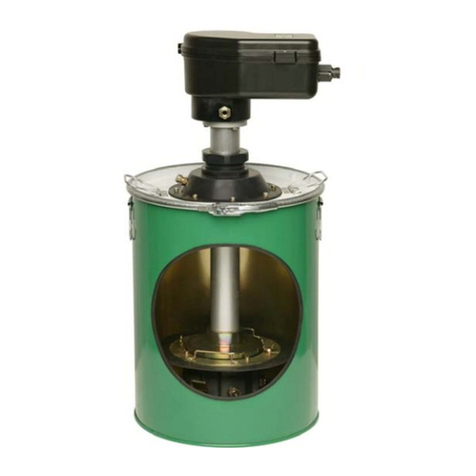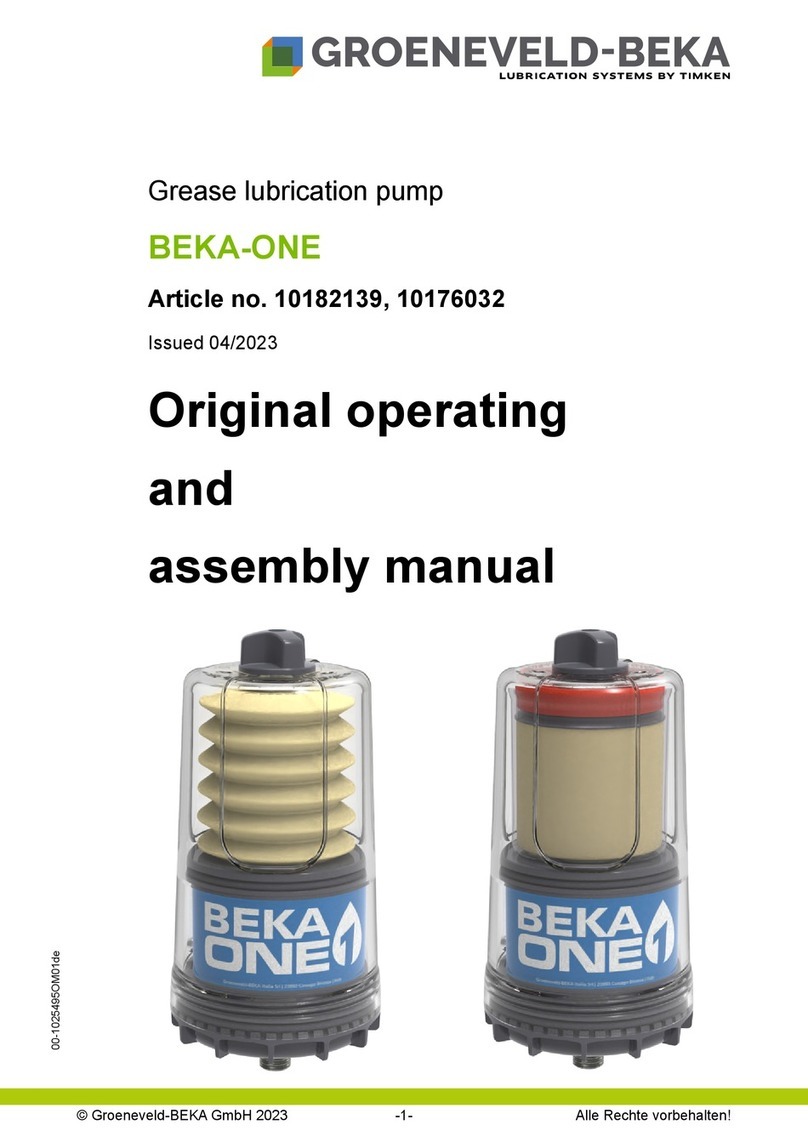
F210613 rev.00
Werking van de Twin-3 elektrische vatpomp (fig. A & B)
Het hart van de vatpomp wordt gevormd door een elektrisch aangedreven
pompunit die bestaat uit een 5-tal radiaal geplaatste vaste cilinders met zuigers
(25). Een elektromotor (19) drijft, via een mechanische overbrenging een as aan
met een daarop bevestigd excentriek. Dit excentriek beweegt de vijf zuigers (25)
heen en weer, die het vet via de vetkanalen naar het vetsmeersysteem pompen.
Behalve het excentriek drijft dezelfde as een roerwerk (13) aan dat zich onder
de pompunit bevindt. Het vet wordt hiermee door naar boven gestuwd. Tussen
de vetkanalen bevindt zich een drukoverstortklep (12), die ervoor zorgt dat de
vetdruk de 250 bar niet overschrijdt.
Bovenin de vatpomp bevindt zich een elektronische besturingseenheid (16),
elektromotor (19) en een 5/2-weg ventiel met twee magneetspoelen (20). Aan
het begin van een smeercyclus activeert de besturingseenheid één van de twee
magneetspoelen en start vervolgens de elektromotor (19). Het vet wordt uit het
vat via het 5/2-weg ventiel naar het hoofdleidingkanaal A (21) of B (22) gepompt.
De stand van dit 5/2-weg ventiel bepaald naar welke primaire vetleiding (4 of 5)
het wordt gepompt. Tijdens deze zogenaamde pompfase neemt de vetdruk in
de primaire vetleiding toe. In een doseurblok (7) is een vetdrukschakelaar (6)
gemonteerd, die een signaal aan de besturingseenheid (16) geeft als een vooraf
ingestelde vetdruk waarde is bereikt. De pomp stopt, maar de primaire vetleiding
blijft door het 5/2-weg ventiel wel op druk, omdat de magneetspoel bekrachtigt
blijft. De periode dat de primaire vetleiding nog op druk wordt gehouden, is een
instelbaar percentage van de periode waarin is gepompt; dit noemen we de
‘nasmeerfase’.
Aan het einde van deze 'nasmeerfase' wordt het 5/2-weg ventiel geopend door
de bekrachtige magneetspoel te deactiveren en de andere magneetspoel te
activeren. Het vet kan uit de primaire vetleiding terugstromen naar het vat,
waardoor de druk zal afbouwen ‘drukafbouwfase’. Na de ‘drukafbouwfase’ wordt
de magneetspoel gedeactiveerd. De ‘drukafbouwfase’ is even lang als de
‘nasmeerfase’. De resterende tijd van deze cyclus wordt gebruikt voor een
‘pauzefase’ tussen twee cycli. Pas daarna volgt een volgende cyclus, maar nu
in de andere primaire vetleiding.
Boven het vet bevindt zich een volgzuiger (15). Als het vetniveau daalt, zakt de
volgzuiger mee onder invloed van zijn eigen gewicht. De volgzuiger sluit de toe-
treding van lucht en condensatiewater uit en voorkomt daarmee:
• Oxidatie van het vet.
• Vermenging van het vet met condensatiewater.
• Verzeping van het vet.
De minimumniveauschakelaar (14) bewaakt het vetniveau in het vat. Bereikt het
vet het minimale niveau, dan meldt de minimumniveauschakelaar dat aan de
besturingseenheid (16).
1. GEBRUIKSAANWIJZING






























